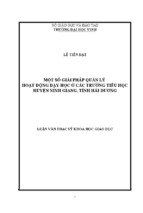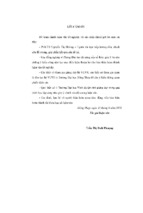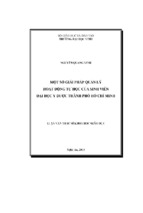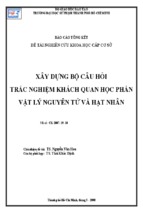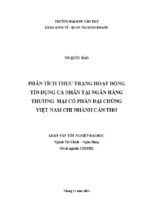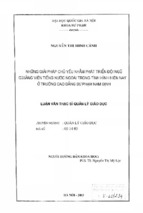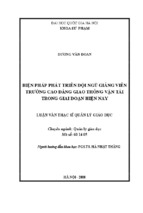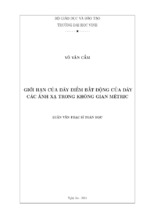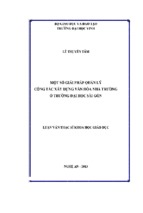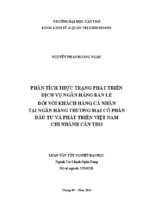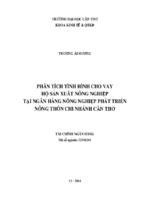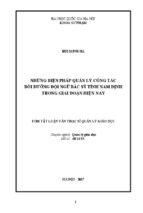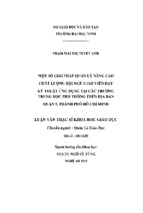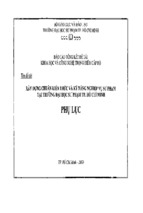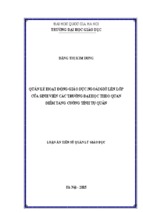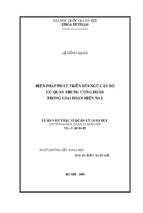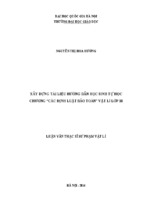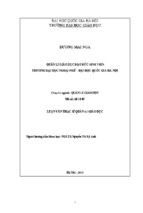1
2
MINISTRY OF EDUCATION AND TRAINING
The study has been completed at College of Foreign Languages,
UNIVERSITY OF DANANG
University of Danang
TRƯƠNG THỊ THANH HIỀN
Supervisor: NGUYỄN THỊ QUỲNH HOA, Ph.D
A DISCOURSE ANALYSIS OF FILM REVIEWS
IN ENGLISH AND VIETNAMESE
Examiner 1 : Trần Quang Hải, Ph. D
Examiner 2 : Assoc. Prof. Dr. Trần Văn Phước
Field
Code
: The English Language
:
60.22.15
The thesis was orally defended at the Examining Committee
Time : 3-11-2011
Venue : University of Danang
MASTER THESIS IN ENGLISH LANGUAGE
(A SUMMARY)
The Origin of the thesis is accessible for the purpose of reference at:
Danang, 2011
- The College of Foreign Languages Library, University of Danang
-
Information Resourse Centre, University of Danang.
3
4
Chapter 1
INTRODUCTION
Through the above example, we can see that there are many
features showed in the italic words such as emotive adjectives,
intensifier, personal pronouns, conjunctions, cleft sentences, passive
sentences. These are the dominant features of film reviews in both
English and Vietnamese. However, between EFRs and VFRs there
are some distinctions. Thus, “A Discourse Analysis of Film Reviews
in English and Vietnamese” is chosen as the title of my thesis. I hope
that my study results will provide some useful knowledge of film
review language and it is also of some help to Vietnamese learners
in improving their English writing skill.
1.2. AIMS AND OBJECTIVES
1.2.1. Aims of the Study
- To identify the discourse features of film reviews in English
and Vietnamese.
- To find out similarities and differences between the two
languages in terms of their discourse features in order to raise
language users’ awareness of film reviews and provide some
useful information for Vietnamese learners of English.
1.2.2. Objectives of the Study
- To describe the discourse features of film reviews in English
and Vietnamese in terms of their layout, syntactic structures,
lexical choice and cohesive devices.
- To compare and contrast the discourse features of film reviews
in English and Vietnamese to find out the similarities and
differences between them in term of their layout, syntactic
structures, lexical choice and cohesive devices.
- To suggest some implications for teaching and learning English
to Vietnamese learners as well as writing of film reviews .
1.3. SCOPE OF THE STUDY
In this thesis we only take the samples from a number of
websites on the internet. And the study is defined in comedies,
thrillers, love story films, action films, socio-psychological films and
1.1. RATIONALE
Nowadays, there are many ways of entertaining. Films are a
popular source of entertainment and it is also considered to be an
important art form, a powerful method for educating or indoctrinating
if we have a good choice. Thanks to the film reviews, we can choose
a suitable and interesting movie for seeing and enjoying. This means
that film reviews are references for moviegoers. Moreover, anyone
who is not familiar with a movie will look for its review to figure out
exactly what the movie is about.
In order to write a good review, it is not only to have a good
writing skill but also to be able to see the whole film with a critical
eye. Let us have a look at the following example:
[...] Trong một cuộc ñua xe, anh bị cảnh sát vây bắt. Cùng bị
bắt với Hoàng còn có Hải, một tay ñua bí ẩn. Sau khi ra tù, Hoàng
quyết tâm xa lánh băng nhóm ñể làm lại cuộc ñời. Hoàng xin vào làm
cho gara sửa xe của ông chủ Linh. Nhưng con ñường hoàn lương
không bao giờ là ñơn giản và dễ dàng.Đại ca Trần quyết truy tìm anh
ñể giao lại nhiệm vụ cũ. Anh cự tuyệt, không chấp nhận trở lại băng
nhóm. Không còn cách nào khác, ñại ca Trần ra lệnh thủ tiêu anh ñể
ñề phòng bí mật các hoạt ñộng phạm pháp của mình bị cảnh sát phát
hiện. Một cuộc truy sát Hoàng ñược dấy lên trong giới giang hồ.
Trên ñường chạy trốn, anh ñược sự hỗ trợ của Hải. Hoàng dần nhận
ra, Hải chính là trinh sát công an ñược cài vào giới giang hồ ñể tìm
chứng cứ tội phạm của ông Trần.
Ngoài diễn viên gạo cội Nguyễn Chánh Tín, Lệnh xóa sổ còn
gây ấn tượng với hai diễn viên tay ngang là ca sĩ Tuấn Hưng và
người mẫu Vĩnh Thụy. Họ ñã thể hiện vai giang hồ khá sinh ñộng và
thuyết phục khán giả. Diễn viên chính Trần Kim Hoàng thể
hiện những màn võ thuật công phụ, hấp dẫn.[...]
[87]
5
6
historical films. Moreover, this thesis is limited to analyze discourse
features of film reviews such as the layout, lexical choice, syntactic
structure, especially cohesive devices of writing English and
Vietnamese film reviews .
1.4. RESEARCH QUESTIONS
1. What are the discourse features of film reviews in English
and Vietnamese in terms of their layout, lexical choice,
syntactic structure, and cohesive devices?
2. What are the similarities and differences between English
and Vietnamese film reviews in terms of their layout, lexical
choice, syntactic structures, and cohesive devices?
3. What are some suggestions for teaching and learning English
to Vietnamese learners as well as writing film reviews ?
1.5. SIGNIFICANCE OF THE STUDY
As mentioned above, film is a mean of entertainment and
reading film reviews is a way to find out the best film for enjoying.
However, it is not easy to write an effective film review in English or
Vietnamese. Hence, the thesis “A discourse analysis of film reviews
in English and Vietnamese” is an attempt to find out the similarities
and differences of the two languages in terms of their layout, lexical
choice, syntactic structures and cohesive devices. It is hoped to
contribute some knowledge to teaching and learning English to
Vietnamese learners as well as writing film reviews.
1.6. ORGANIZATION OF THE STUDY
Chapter 1: Introduction
Chapter 2: Literature Review
Chapter 3: Methods and Procedures
Chapter 4: Finding and Discussion
Chapter 5: Conclusion, implications, limitations, suggestions
for further research
CHAPTER 2
LITERATURE REVIEW
AND THEORETICAL BACKGROUND
2.1. LITERATURE REVIEW
Contents about discourse and discourse analysis are
mentioned in many books: [5], [30],[13], [14], ect.
In Vietnam, the study of discourse and discourse analysis has
been done by many linguists such as Diệp Quang Ban [32], Trần
Ngọc Thêm [44] , Nguyễn Hòa [16] etc.
In addition, in Vietnam, the study of discourse and discourse
analysis are presented in many theses such as [27], [8],[21] etc.
Up to now, there has been almost no research about film
reviews in English and Vietnamese. Thus, “A Discourse Analysis of
Film Reviews in English and Vietnamese” is chosen for my topic.
2.2. THEORETICAL BACKGROUND
2.2.1. Text and Discourse
2.2.1.1. Concepts of Text
“Text” is defined by many linguists: Halliday and Hasan
[11], [12], Crystal [6], Nunan [20]. With different concepts about
“Text”, in this study I refer to Text as a semantic unit of language in
written form which is included form and structure.
2.2.1.2. Concepts of Discourse
In this part, we review some definitions related to discourse
of the linguists such as Cook [5], Brown and Yule [3], Nunan [20],
Widdowson [29] Crystal [6]. In this thesis I view discourse as
language in use or stretches of language which has meaning, unity
and purpose.
2.2.2. Discourse Analysis
In this part, we review some definitions related to discourse
of the linguists such as Cook [5], Brown and Yule [3], Nunan [20],
7
8
Widdowson [29] Crystal [6]. I view discourse analysis as the study of
how and for what purposes language is used in a certain context and
the linguistic means to carry out these purposes.
2.2.3. Spoken and Written discourse
In discourse analysis a distinction is often made between
spoken and written discourse. This distinction is showed by Halliday
[12], Halliday and Hasan [11], Cook [5], Akinnaso [1], Crystal [6].
2.2.4. Cohesion and Coherence in Discourse
2.2.4.1. Cohesion
There are many views on cohesion, but in this thesis we take
the view of Halliday and Hasan [11], which is how words and
expressions are connected by using cohesive devices which
categorized into five different types, namely, reference,
substitution, ellipsis (these three types called grammatical
cohesion), lexical cohesion and conjunction (borderline between
grammatical and lexical cohesion)
2.2.4.2. Coherence
Coherence has been seen as one of the prime conditions or
characteristics of a text: “Without coherence, a text is not properly a
text” says Hatch [14]. We review the views of Palmer [23], Nunan
[20]. Through all the views above, we can say that coherence is used
to refer to semantic relationships between sentences, phrases and
paragraphs in a text.
2.2.5. Film
According to Oxford Advanced Learner’s Dictionary [22],
“Film is a series of moving pictures recorded with sound that tells a
story, shown on television or at the cinema/ movie theater.”
2.2.6. Review
In the Oxford Advanced Learner’s Dictionary [22], “Review
is a report in a newspaper or magazine, or on the Internet, television
or radio, in which somebody gives their opinion of a book, play,
film/movie, etc.”
According to the website http://dictionary.reference.com/
browse/review “Review is a critical article or report, as in a
periodical, on a book, play, recital, or the like; critique; evaluation.”
2.2.7. Film Review
The website [53] defines “Film review is a critique,
evaluation of a movie.”
In this study we mention film review is a critical article in a
newspaper or magazine on the Internet, in which somebody gives
their critique, evaluation of a film , their opinions and a brief
summary of a film.
CHAPTER 3
RESEARCH METHODS AND PROCEDURES
3.1. DESIGN
The design of the thesis is based on combining qualitative
and quantitative approaches.
3.2. RESEARCH METHODS
I use the descriptive method, the analytic method, the
comparative method. Moreover, inductive and reductive methods are
inevitable.
3.3. RESEARCH PROCEDURES
3.4. DATA COLLECTION AND ANALYSIS
3.4.1. Data Collection
3.4.2. Data Analysis
3.5. RELIABILITY AND VALIDITY
9
10
CHAPTER 4
FINDINGS AND DISCUSSION
4.1. LAYOUT IN EFRs AND VFRs
Basically, the layout of a film review includes four sections:
Introduction, Plot Summary, Remarks about Film, Overall Verdit.
4.1.1. Introduction Section
In the Introduction Section, writers should mention the main
contents such as the name of a film, director, cast, genre, time and
place [50]. All of the information will help readers understand the
movies better.
Table 4.1. Examples illustrating the Introduction in EFRs
Name of
Example
Director
Cast
Genre
the Film
(4.1)
The
Brad
Matthew
thriller
Lincoln
Furman
McConaughey
Lawyer
(4.2)
Take Me Michael
Topher Grace , comedy
Home
Dowse
Teresa Palmer,
Tonight
Chris
Pratt,
Anna Faris
(4.3)
Dan In Ø
Steve Carell
Not really
Real Life
a comedy,
but
a
tender,
bittersweet
romance
(4.4)
Sarah’s
Gilles
Ø
Ø
Key
PaquetBrenner
With VFRs, the Introduction Section includes the contents:
name of the film, director, cast, number of episodes, no more three
sentences about the main contents of the film, time and place to show
and genre.
There are some distinctions in the part Introduction between
EFRs and VFRs, namely, this part of EFRs has four parts, but it has
four more parts in VFRs such as main contents of the film, number of
episodes, time and place for showing. Moreover, the contents in the
introduction are interchangeable. In addition, all the parts of the
introduction are not always present, some contents may be omitted
such as director, cast, genre, number of episodes, main contents of
the film, but the name of the film is always present in both languages.
Two parts that are always present are name of the film and director in
EFRs and name of the film and main contents of the film in VFRs.
4.1.2. Plot Summary
In order to help readers master the main content for a film
before going to remark somethings, writers should present a plot
summary for the movie, but do not reveal the ending. Of all parts,
plot summary is usually the longest.
4.1.3. Remarks about films
When talking about the positive points in a film, writers
emphasize the good, whereas the negative points are criticism,
dissatisfaction. In this section, writers discuss one or more aspect of
filmmaking: acting, direction, editing, costume design, set design,
photography, background music, or anything else the writer may
think of. [6]
4.1.4. Overall Verdict
Beside the three parts mentioned above, Overall verdict is also
necessary for readers’ attention because they can look at here to define
whether to see the film or not. This section expresses writer’s overall
11
12
reaction to the film as well as her/his opinion on the quality of the film.
It also includes writer’s recommendations for potential viewers.
4.2. LEXICAL CHOICES
4.2.1. Emotive Adjectives
Table 4.3 Emotive adjectives in EFRs and VFRs
English
Vietnamese
Type
Occ
Rate
Occ
Rate
Positive Adjectives
268
60.9%
379
78.3%
In the table (4.5), intensifiers in VFRs were used with a quite
dominant number (124 examples), whereas only 83 examples are
found in EFRs. Thus, writers of film reviews in Vietnam have a
tendency to use intensifiers. But amplifiers took the higher
percentage than downtoners in both languages (89.2% versus 85.2%).
However, amplifiers of VFRs added up 106 instances, whereas only
had 74 examples of EFRs.
Among of amflifiers in VFRs, “khá” and “quá” were used as
the most popular ones. With the total 106 instances of amflifiers, 47
instances belonged to these (44,3%). Here is an example:
(4.24) [...] Để tạo yêu tố ăn khách và khai thác sâu những
mâu thuẫn diễn ra giữa ñôi vợ chồng trẻ Ba Quang và Mai Duyên,
ñạo diễn Ngọc Phong ñã khá mạnh tay khi lột tả những cảnh phòng
the. Hạn chế của phim có lẽ chỉ là do thời lượng hai tiếng nhưng
phim lại có quá nhiều biến cố khiến cách giải quyết những xung ñột
có vẻ quá ñơn giản và dễ ñến khó tin.
With EFRs, writers used “too, quite, a bit” which reached
47,8% with 35 examples in a total of 73 ones. Below is an illustration:
(4.25) [...] The whole film feels a bit noir in terms of tone,
but the blaring effects don't allow for much introspection overall.
This would be a difficult film to hate but not a difficult film to be a
bit bored by.
[61]
4.3. SYNTACTIC FEATURES
4.3.1. Cleft Sentences in EFRs and VFRs
Based on the concept of Quirk et al, a cleft sentence is a complex
sentence with two clauses, namely, main clause and subordinate clause. In
brief, the form of a cleft sentence in English is described:
Negative Adjectives
Total
172
39.1%
105
21.7%
440
100%
484
100%
The table above shows that emotive adjectives in EFRs and
VFRs took a very large number with 440 and 484 instances. However,
the number of positive adjectives added up to 268 (EFRs) and 484
(VFRs) while the negative ones quite low (172 versus 105). In order to
express contents or evaluate a film, writers of EFRs used the positive
adjectives “ good, interesting, exciting, romantic, brilliant, great,
excellent, etc”, and in VFRs “hấp dẫn, lôi cuốn, sinh ñộng, thú vị tình
cảm, lãng mạn, cảm ñộng, hài hước, ngoạn mục, etc”.
Actually, writers of EFRs and VFRs combined the emotive
adjectives with the nouns/ noun phrases to evaluate the quality of
films. These nouns/ noun phrases are shown in the table (4.4)
4.2.2. Intensifiers in EFRs and VFRs
Below is the table showing intensifiers in EFRs and VFRs:
Table 4.5 Intensifiers in EFRs and VFRs
English
Vietnamese
Intensifiers
Occ
Rate
Occ
Rate
Amplifiers
74
89.2%
106
85.5%
Downtoners
9
10.8%
18
14.5%
Total
83
100%
124
100%
It + Be(is/was) + Focal Element + Subordinate Clause
Here are some examples:
13
(4.31) [...] It’s a film that fascinates as much as it frustrates.
[65]
(4.32) [...] It’s a bold, foolhardy flourish that proves as
distracting as it is disorienting.
[66]
In VFRs, in order to make readers pay attention to new
information, Vietnamese writers give emphasis by using the word
“Chính”. It is the word that is used commonly in VFRs.
Below are two common emphatic forms found in VFRs.
(a)
Focal element + chính + “là” + Clause
(b)
Chính + Focal Element + “là” + Clause
(4.37) [...] Một ñiểm nhấn ñặc biệt của ‘Ma làng’ chính là
"lạ hóa" các gương mặt cũ, thông qua việc ñạo diễn ñã dám giao
những vai diễn khác hẳn với khung hình tượng của các diễn viên
trước nay mà NSƯT Bùi Bài Bình trong vai thư ký ủy ban Tòng là
một ví dụ sinh ñộng.
(4.40) [...] Chính cái ñỏng ñảnh trẻ con qua cách diễn của
Bảo Thy khiến khán giả cười vui mà không thấy lố bịch.
4.3.2. Passive Voice in EFRs and VFRs
The construction of the passive voice is described:
Goal + V(be+P.P) + by + Actor/Agent (c)
(4.41) [...] the cast is joined by Natalie Portman.
(4.42) […] Number Four (Alex Pettyfer) is one of nine gifted
residents (each branded with a number, for reasons not sufficiently
explained in the film) from the planet Lorien, who fled to Earth after
their civilization was annihilated by the Mogadorians.
It is noteworthy that in some cases the authors use ‘by- phrase’
14
but they are not the passive sentences. Below are some illustrations:
(4.46) but he jeopardizes his inheritance by falling for a girl
of humble means (Greta Gerwig).
Besides the full passive form as in (c), there is a kind of
passve without the goal and the form of ‘to be’ is usually used in
EFRs. In the toal of 341 passive sentences, there is only 12% with 41
examples belonging to this category. For example:
(4.48) [...] Directed by Alastair Fothergill and Keith Scholey,
African Cats follows two families of felines in a remote valley in
Kenya’s 580-square-mile Masai Mara National Reserve.
In Vietnamese, Đỗ Việt Hùng (38, p.29) states that a passive
sentence is recognized by the three main following constructions:
Goal + Vtransitive (d)
Goal + bị/ñược + Vtransitive (e)
Goal + bị/ ñược/ do + Agent + Vtransitive (f)
After analysing the data, we found that most of the passive
sentences belong to the constructions (e) and (f). Following are
[101]
illustrations for the case (e):
(4.50) “Giao lộ ñịnh mệnh” ñược ñánh giá là chứa nhiều yếu
[105]
tố mới lạ trong một kịch bản phim ñầy tình tiết lôi cuốn.
Beside this passive fomular, there is also another one used
commonly in VFRs is “Goal + bị/ ñược/ do + Agent + Vtransitive”.
For examples:
(4.53) Bộ phim do 2 ñạo diễn Trọng Trinh và Hồng Sơn thực
[84]
hiện. Phim quy tụ dàn diễn viên trẻ Hồng Diễm, Diệu Hương, MC
Phan Anh, MC Đan Lê, Hồng Đăng…
As mention above, there are the two main passive formulas
used in VFRs. However, we discovered more than one construction.
[72]
It can be describe as “ Goal + bị/ ñược + Vtransitive + bởi/
bằng/qua+ Actor/ Agent” (g). For example:
15
16
(4.55) Không to tát ở khâu ñặt vấn ñề nhưng phim ñược mở
màn bằng 1 cảnh tượng sốc, khiến khán giả ñã bị ấn tượng ngay từ
ñầu – một thành công bước ñầu.
In this structure we see that it is similar to the passive
construction in EFRs “Goal + V(be+P.P) + by + Actor/Agent”.
However this formula is used less than the one in EFRs. We found 15
instances belonging to this form in the toal of 376 examples.
Table 4.11 Passive Voice in EFRs and VFRs
English
Vietnamese
Passive
Occ
Rate
Occ
Rate
with Actor/Agent
37
10.4%
120
31.9%
without Actor/Agent
318
89.6%
256
68.1%
Total
355
100%
376
100%
Look at the following examples:
(4.62) [...] The storyline is essentially unchanged.
(4.63) [...] Khánh Ngọc bị vô sinh.
In the example (4.62), the agent does not obviously appear because
it is not suitable in this situation. And in (4.63), the agent is unknown, the
writer does not want readers to know about the plot of the film.
4.4. COHESIVE DEVICES
4.4.1. Grammatical cohesion in EFRs and VFRs
Table 4.12 Grammatical cohesion in EFRs and VFRs
Grammatical
cohesion
Reference
Substitution
Ellipsis
Conjunction
Total
English
Vietnamese
Occ
Rate
Occ
Rate
1284
25
29
298
1636
78.5%
1.5%
1.8%
18.2%
100%
614
85
4
560
1263
48.6%
6.8%
0.3%
44.3%
100%
[108]
4.4.1.1. Reference in EFRs and VFR
Table 4.13 Reference in EFRs and VFRs
REFERENCE
Types
English
Occ
Rate
418
32.6%
Vietnamese
Occ
Rate
371 60.4%
Personal
Pronoun
Personal
Possessive
1
0.1%
79 12.9%
Pronoun
Possesive
594
46.3%
Determiner
Total
1013
79%
450 73.3%
Determiner
142
11.1%
87 14.2%
Demonstrative Adverb
4
0.3%
5
0.8%
[87]
Total
146
11.4%
92 15%
[90]
Comparative
General
15
1.17%
7
1.1%
Particular
110
8.6%
65 10.6%
Total
125
9.8%
72 11.7%
(i) The use of personal reference in EFRs and VFRs
Personal reference is divided into three categories: personal
pronoun, possessive pronoun and possesive determiner, Halliday and
Hasan (11) view. As we can see from the table 4.13, Of three
categories of reference, the rate of personal reference is the highest
(79% in English and 73.3% in Vietnamese). So we can realize that
writers of both EFRs and VFRs use this type as a frequent means to
make cohesion within the text. In English, personal reference can
divided into personal pronoun, possessive pronoun and possesive
determiner but these does not exist such distinction in Vietnamese, so
in Vietnamese we call possesive forms in general. In EFRs, possesive
18
17
determiner has the highest rate (46,3% with 594 examples),
possessive pronoun has the lowest rate with only one instance
(0.1%). Compared to VFRs, the rate of possesive forms in EFRs is
higher with the percentage 46.4%. Anyway, personal reference in
both languages is considered a means of making cohesion by writers
of film reviews. For example:
(4.68) [...] Ngay như Nương, cuộc ñời tưởng sẽ suôn sẻ hơn
anh chị mình nhưng ñể vươn tới ước mơ trở thành ngôi sao màn bạc,
cô cũng phải trải qua nhiều vấp ngã.
(4.69) [...] Nhân vật chính của phim là Tèo - anh chàng vừa
ñể mất người yêu vào tay gã Việt Kiều, quyết bỏ quê lên Sài Gòn
những mong kiếm tìm hạnh phúc. Số phận ñưa ñẩy anh gặp những
tay xã hội ñen khét tiếng ñang tìm kiếm người thế vai Long Ruồi - kẻ
ñang sống thực vật sau khi bị thù thanh toán.
(ii)The use of demonstrative reference in EFRs and VFRs
With this category, EFRs were used more commonly than
VFRs (146 instances versus 92 instances). In spite of such
differences, there is a similarity between EFRs and VFRs is the use
of adverbs with the very low rate (0.3% in EFRs and 0.8% in
VFRs). Thus, this class is not a dominent cohesive device.
Another type of demonstrative reference is determiner “this,
that, these, those”. This category was used with the following
percentages- 9.6% in EFRs and 14.2% in VFRs. We can see the rate
of EFRs is higher than VFRs. Here are some illustrations:
(iii) The use of comparative reference in EFRs and VFRs
Comparative reference plays an important role in expressing
the similarity or difference between things. Most comparatives are
used for anaphoric reference, so they create the cohesion between
sentences and show prominent ideas in a text. Comparative
reference is used in both of EFRs and VFRs with the low percentage
(9.8% versus 11.7%). For example:
(4.76) [...] On paper, Observe And Report couldn’t be more
similar to Paul Blart: here’s another delusional chubster who lives
with mum, patrols a shopping centre and has the hots for a sales girl
way out of his league.
(4.77) [...] As the latest slice of folklore adapted by Peter
Morgan and starring Michael Sheen (The Deal, The Queen,
[93]
Frost/Nixon), it’s the best of the duo’s collaborations.
(4.78) [...] Hai bà mẹ lớn tuổi thì ứng xử không giống ai, ăn
nói như trẻ con, gọi nhau là Thúy Vân, Thúy Kiều như… dở hơi!
(4.79) [...] So sánh với những bộ phim ñã và ñang phát sóng
dành cho lứa tuổi teen hiện nay thì Mùa Hè sôi ñộng có lẽ là một bức
[110]
tranh trong trẻo nhất khắc họa về lứa tuổi này.
In the examples above, “similar to” in (4.76) and “không
giống” in (4.78) are general comparatives, but “the best”, “nhất” in
(4.78) and (4.79) are particular ones.
4.4.1.2. Substitution in EFRs and VFRs
Table 4.14 Substitution in English and in Vietnamese
SUBSTITUTION
Type
Nominal
Substitution
Verbal
Substitution
Clausal
Substitution
Total
English
Occ
Rate
17
0.9%
Vietnamese
Occ
Rate
47
3.7%
3
0.2%
0
0
5
0.3%
38
3%
25
1.4
85
6.7
19
20
From the table, we can see that substitution in EFRs and
VFRs is used with the very low rate. There are only 25 examples of
substitution in English film reviews with the rate 1.4%, in
Vietnamese ones, it is higher with 85 instances (6.7%).
4.4.1.3. Ellipsis in EFRs and VFRs
Table 4.15 Ellipsis in EFRs and VFRs
hiện rất ñạt một Thiên Kim kiêu kỳ, ñố kỵ, sẵn sàng hại tất cả những
ai dám cản ñường tiến thân của mình.
[114]
Unlike EFRs, VFRs did not appear verbal and clausal
ellipsis. VFRs only contain nominal ellipsis with the lowest rate.
4.4.1.4. Conjunction in EFRs and VFRs
Table 4.16 Conjunction in EFRs and VFRs
ELLIPSIS
CONJUNCTION
Type
Nominal
Ellipsis
Verbal Ellipsis
Clausal Ellipsis
Total
English
Vietnamese
Occ
18
Rate
1%
Occ
4
Rate
0.3%
7
4
29
0.4%
0.2%
1.6
0
0
4
0
0
0.3%
Ellipsis, like substitution, it is used to make ties to nominals,
verbals, and clauses. Ellipsis is one of devices that gives text
cohesion. However, we look at the table (4.15), it takes a very low
percentage with ellipsis in both of languages (only 0.3% in VFRs,
1.6% in EFRs). Especially, most of ellipsis in EFRs and VFRs belong
to the nominal type. For example:
(4.87)[...) Typical. You wait decades for a mall-cop movie
and then two Ø arrive at once.
[79]
(4.88) [...] Chuyện tình ñảo ngọc có nhiều người ñẹp. Nam
thì có người mẫu Vĩnh Thụy, Hoàng Anh, Đức Tiến. Nữ thì có người
ñẹp nhân ái Chung Thục Quyên, hoa hậu Cao Thùy Dương, người
ñẹp Phụ nữ thế kỷ 21 Kim Tuyến. Cả 3 cô ñều sinh năm 1987. Tất cả
Ø ñã không ngại cái nắng gió của biển Nha Trang ñể quay ròng rã 4
tháng. Hoa hậu Cao Thùy Dương lần ñầu ñóng phim nhưng ñã thể
Type
Additive Conjunction
Adversative Conjunction
Causal Conjunction
Temporal Conjunction
TOTAL
English
Occ
Rate
142
7.8%
129
7.1%
15
0.8%
12
0.7%
298
16.4%
Vietnamese
Occ
Rate
209
16.5%
178
14.1%
112
8.9%
61
4.8%
560
44.3%
4.4.2. Lexical Cohesion in EFRs and VFRs
Table 4.17 Lexical Cohesion in EFRs and VFRs
LEXICAL COHESION
English
Vietnamese
Occ
Rate
Occ
Rate
Repetition
897
97.7%
1206
96.8%
Synonym
21
2.3%
34
2.7%
0
0
0
0
[79]Superordinate
Total
918
100%
1240
100%
Through the table (4.17), we see that writers used this
category commonly, but compared to EFRs (918 instances) lexical
cohesion in VFRs takes the higher number with 1246 examples. The
most dominant type of lexical cohesion in both of languages is
repetition (97.7% versus 96.8%). Repetition is the reiteration of the
Type
21
precious lexical item in the text with the aim of drawing readers’
attention to emphasize or reinforce words or phrase. Of three types,
repetition is the simplest form of lexical cohesion. For example:
(4.100) [...] Your Highness reaches its homoerotic apex
during a pivotal scene in which Thadeous, in his first real act of
bravery, intervenes to prevent Courtney from being raped by a
minotaur, which minotaur happens to be sporting a massive
erection. [...]
And Your Highness does throw in a few hetero bits to help
balance the sexual ledger, especially when the cast is joined by
Natalie Portman, playing a feisty fellow-quester and McBride’s
unlikely romantic foil.[...]
Your Highness is often wickedly funny – a filthy, spot-on
send-up of The Beastmaster, Krull, and other campy '80s fantasy
flicks.
[84]
(4.101) [...] Câu chuyện ñược bắt ñầu từ một làng quê miền
biển qua nhân vật Tuấn, một học sinh lớp 8. Kỳ nghỉ hè, Tuấn ñược
ba mẹ cho lên nhà cậu Duy ở thành phố chơi và ôn tập cho kỳ thi
cuối cấp. Lần ñầu tiên ñược lên thành phố, trong ñầu Tuấn hiện lên
một viễn cảnh thành phố hoa lệ với mọi thứ ñều hiện ñại, ñược vui
chơi thỏa thích. Tuy nhiên, sau một thời gian sống ở nhà cậu Duy,
Tuấn cảm thấy khó chịu hơn là thích thú bởi mọi thứ ñều phải theo
một chuẩn mực, quy ñịnh khắt khe. Nhưng rồi bằng trí thông minh và
sự lém lỉnh, Tuấn ñã thuyết phục ñược gia ñình cậu Duy thay ñổi
việc bắt con cái học hè ñể mọi người có một kỳ nghỉ hè thực sự.
[88]
The italic words in both examples above are the repetition of
lexical cohesion. Writers wanted to emphasize the title of the film
“Your Highness” and the name of the film character “Tuấn”. In
(4.101), the writer repeated the word with the purpose of drawing
22
readers’ attention to the long contents through three paragraphs.
Below are the samples of synonym:
(4.102) [...] From the moment Hailee Steinfeld enters the
frame in Joel and Ethan Coen’s magnificent western True Grit, an
adaptation of Charles Portis’ 1968 novel (or re-adaptation — John
Wayne's 1969 version got to it first), the film belongs to her. This is
no easy feat, especially for a 13-year-old actress making her featurefilm debut, but Steinfeld not only holds her own alongside such
heavyweights as Jeff Bridges, Matt Damon, and Josh Brolin, she
often upstages them.
[57]
(4.103) [...] Chuyện xoay quanh những mảnh ñời ở xóm
ñường sắt, nơi mà những trẻ em ít học, lớn lên trong những gia ñình
nghèo khó trở thành những cuộc ñời du thủ du thực, nhảy tàu, trộm
cướp, ñánh nhau... Nổi trội ở cái xóm rền tiếng còi tàu ấy là hai băng
nhóm thanh thiếu niên, dẫn ñầu là Bình Bò (Lưu Quang Anh thủ vai)
[84]
và Tý Ngão (Phan Thanh Tân thủ vai).
[118]
By using different expressions, the writers created the
connection between sentences as in (4.102) the cast “Hailee
Steinfeld” was restarted by “a 13-year-old actress” or in (4.103)
“xóm ñường sắt” was changed by the related meaning “xóm rền tiếng
còi tàu”. Writers of film reviews in both of languages used this type
with the low rate (2.3% versus 2.7%).
In short, cohesion device plays very important role of making
the cohesive sentences within a text. Reference, substitution, ellipsis,
conjunction, repetition, synonym and superordinate are discoursal
equipments or ties to make cohesive devices which signal relations
between sentences and parts of texts. The typical features of film
reviews in English and Vietnamese have been clearly showed in this
chapter.
23
24
CHAPTER 5
CONCLUSIONS AND IMPLICATIONS
5.1. CONCLUSIONS
With the aim of investigating and analyzing some typical
features about the discourse in EFRs and VFRs in order to find out
the similarities and differences between them, we set up the major
goals for the thesis in terms of the layout, lexical choices, syntactic
features and cohesive devices.
In terms of the layout, both EFRs and VFRs contain the three
main parts: Introduction, Plot Summary and Remarks about films.
However, the part Overall Verdict in VFRs occupies a low rate with
6%. Beside that, the part Introduction between EFRs and VFRs also
shows some differences. Firstly, EFRs usually include four contents,
but VFRs have four more contents such as main contents of the film,
number of episodes, time and place for showing. The part Remark
has a prominent difference, writers of EFRs have a tendency using
both positives and negatives in film, whereas, writers of VFRs
mention positives as the prominence. The remaining content “Plot
Summary” is longest and similar to both languages similar and
considered the longest.
With lexical choice, firstly, emotive adjectives in EFRs and
VFRs add up a large number with 440 and 484 instances. However,
the number of positive adjectives in EFRs is lower than VFRs (268
versus 484). Whereas, negative adjectives of VFRs only take 105
examples (21.7%), lower than EFRs with the number of 172 (39.1%).
Secondly, the number of intensifiers in VFRs is higher than in EFRs
(124 versus 83). However, amplifiers have the higher percentage than
downtoners in both languages (89.2% versus 85.2%), but amplifiers
of VFRs is more prominent than EFRs (106 versus 74 instances).
In terms of syntactic features, firstly, cleft Sentence in EFRs
is lower than VFRs (15 versus 58 instances), and the formula in
English sentence is “It + be + Focal element + Subordinate Clause”,
whereas Vietnamese Cleft Sentence can be use with the two
formulas: “Focal Element + chính + là + Clause” or “Chính + Focal
Element + là + Clause”. Secondly, talking about passive voice, both
of them have a large number of examples that belong to this category
(355 versus 376). A difference between them is that the passive with
Actor in EFRs is lower than VFRs (10.4% versus 31.9%), whereas
the passive without Actor in EFRs is higher than VFRs (89.6%
versus 68.1%)
The final thing is cohesive devices which are the most
complex feature of all. In general, both of EFRs and VFRs have the
number of grammatical cohesion more prominently than lexical
cohesion (1636, 1263 versus 918, 1246). However, between them
these exist some differences which are shown through the numbers
(1636, 1263 versus 918, 1246). In particular, there are some
differences. Firstly, reference in EFRs is larger than VFRs (1284
versus 614) and with Vietnamese reference there is no distinction
among personal pronoun, possesive pronouns and possessive
determiners. Moreover, in VFRs there is no distinction among kinds
of personal reference. Secondly, substitution in VFRs is higher than
EFRs (6.8% versus 1.4%) but there are not any percentages for
verbal ellipsis in VFRs. Thirdly, both EFRs and VFRs receive a low
rate, especially, verbal and clausal ellipses in VFRs get the rate
“zero”. Fourthly, conjunction in VFRs adds up the number of 560
examples, but only 298 with EFRs. In terms of a dominant
difference is clausal conjunction in EFRs that takes a very small
number with 15 instances while there are up to 112 instances for
VFRs. However, both languages of film reviews does not exist the
25
26
superordinate cohesion. Finally, lexical cohesion, both of them take
the highest rate of repetition (97.7% versus 96.8%), but there are no
any percentages for the superordinate. The remaining types of lexical
cohesion show very low rates.
5.2. IMPLICATIONS
The thesis shows the similarities and differences of film
reviews in English and Vietnamese. Hence, the results will contribute
some useful background to teaching and leaning English to
Vietnamese learners as well as writing film reviews.
To teachers:
I hope that the thesis will be a useful reference resource for
teaching English because it provides more knowledge in the field of
discourse analysis and writing film reviews. From the findings the
similarities and differences of EFRs and VFRs, teachers will master
some discourse features of film reviews in the terms of their layout,
lexical choice, syntactic structures and cohesive devices. Thanks to
this knowledge, teachers can help students know how to write a good
film review.
To learners:
The thesis helps learners master the knowledge of discourse
features of film reviews in terms of the layout, lexical choice,
syntactic structures and cohesive devices. In order to write film
reviews logically and effectively, learners must pay attention to the
above discourse features. Firstly, in terms of the layout, learners must
decide how many parts a film review has and how ideas in each part
are arranged. Secondly, learners must have a good lexical choice to
attract readers and emphasize the quality of a film. Thirdly, defining
the prominant syntactic structures for each film review. Finally, to
create a smooth discourse, cohesive devices are indispensable. I hope
that when Vietnamese learners master the above knowledge, they
will not only have chance to practice writing film reviews but also be
more successful with any categories of discourse.
5.3. LIMITATIONS
Because of limited time and reference books, in this thesis I
only study some discourse features of EFRs and VFRs, namely, their
layout, lexical choice, syntactic structures and cohesive devices. I
collected 100 EFRs and 100 VFRs from some websites with the
length from over 300 to 800 words. The film reviews belong to love
story films, thrillers, comedies, action films, psychosocial films, and
historical films. Besides, each film review has a title but it is not
mentioned in my thesis.
5.4. SUGGESTIONS FOR FURTHER RESEARCH
For the sake of further investigation into the field of film
language, I would like to offer two suggestions below:
1. An Investigation into Movies synopses in English Film
Reviews and Vietnamese Film Reviews
2. An Investigation into the Titles of Film in English Film
Reviews and Vietnamese Film Reviews
- Xem thêm -

